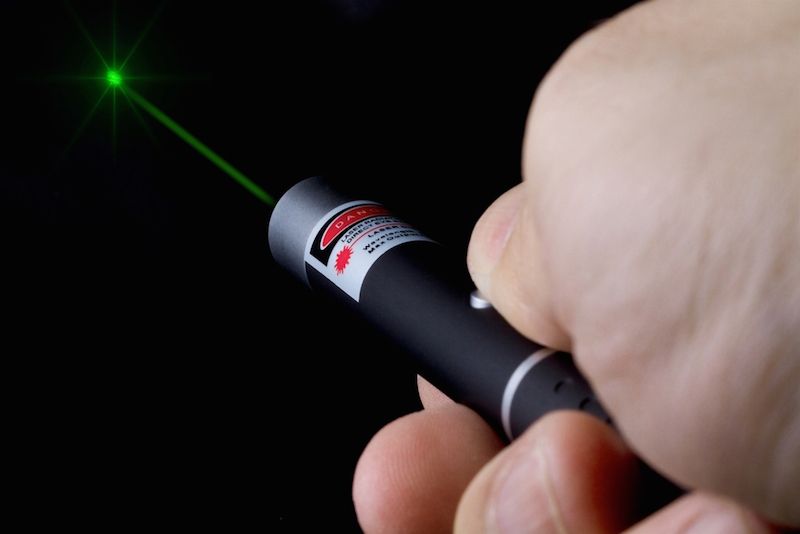Bus Driver Suffers Vision Loss from Child's Toy Laser

A boy who aimed a laser pointer from a toy at the rearview mirror inside a public bus in Germany permanently damaged the retina of the bus driver's right eye, a new case report reveals.
The boy was playing with a laser pointer while sitting about 50 feet (15 meters) away from the driver, according to the case report. When the child pointed the laser at the rearview mirror inside the bus, a beam of red light emitted by the toy reflected off the mirror and into the eye of the 44-year-old bus driver, according to a report published online Oct. 5 in the journal BMJ Case Reports.
Laser pointers are handheld, penlike devices typically used in lectures and business presentations to emphasize information. They are also used by astronomy buffs to point out planets and stars in the sky, and the devices are present in some children's toys as well.
The boy's laser was part of a toy, and initially, the light caused blurred vision in the bus driver's right eye. After this blurriness had continued for six months, the driver sought help from an eye doctor.
After examining the driver, an ophthalmologist diagnosed a subtle but detectable injury to the macula, an area near the center of the retina that is responsible for central vision. However, the vision in the driver's left eye remained normal. [9 Odd Ways Your Tech Devices May Injure You]
The driver had looked into the rearview mirror about three or four times, to try to identify the passenger who was holding the laser, causing additional exposure that increased his chances for an eye injury, the report said.
This is the first reported case of retinal injury caused by the laser beam of a toy, the doctors wrote in the man's case report.
Sign up for the Live Science daily newsletter now
Get the world’s most fascinating discoveries delivered straight to your inbox.
Laser dangers
The light from a laser beam, even if it is reflected off a mirror, can be absorbed by pigmented structures within the retina that can generate heat, and cause a tiny burn, said Dr. Vincent Patalano, chief of ophthalmology at Cambridge Health Alliance and an assistant professor of ophthalmology at Harvard Medical School in Boston, who was not involved in the case. That tiny burn can destroy a small area of the retina, which damages the central part of a person's visual field, he said.
Although lasers can be used to treat some vision problems, such as the damage to the retina that sometimes occurs in people with diabetes, patients are told to never stare directly at the light, and the laser is used for a very short time, Patalano told Live Science.
The light that lasers emit has several properties that can make it dangerous to unprotected eyes. Laser-produced light stays together in one narrow path, and it is focused on one small point, Patalano said. Laser light is also one color, and the eyes are more sensitive to certain colors of light than others, he said. In this case, though, the laser was red, which is not as harmful to the eyes as blue or green lasers, he said.
The intensity of laser light also makes a difference, Patalano said. Although the exact energy output of the boy's toy laser pointer was not known, it was likely a low-energy laser, the case report said.
There's not much that can be done to correct this type of vision damage, Patalano said. It's not clear why the laser affected the man's right eye only, but it could be that the beam reflected at a slightly different angle in each eye, Patalano suggested.
There have been other reported incidents of laser pointers being misused, causing eye problems or putting people at risk of injury. According to a report by the Federal Aviation Administration (FAA), fans have disrupted sporting events by aiming laser pointers at athletes, and people have shined laser pointers at airplanes or helicopters. This is a federal crime in the United States because the glare can temporarily blind pilots, making it difficult for them to safely fly and land an aircraft.
Pilots reported about 3,900 laser incidents to the FAA in 2014, and nearly 4,000 of them in 2013, according to the agency.
The case report authors conclude by recommending that because kids are unlikely to understand the possible risks of lasers, children should not be allowed to use the devices.
Follow Live Science @livescience, Facebook & Google+. Originally published on Live Science.
Cari Nierenberg has been writing about health and wellness topics for online news outlets and print publications for more than two decades. Her work has been published by Live Science, The Washington Post, WebMD, Scientific American, among others. She has a Bachelor of Science degree in nutrition from Cornell University and a Master of Science degree in Nutrition and Communication from Boston University.













